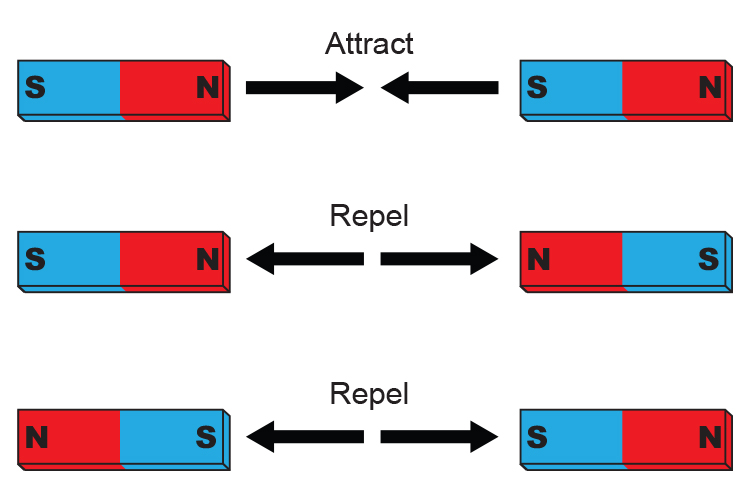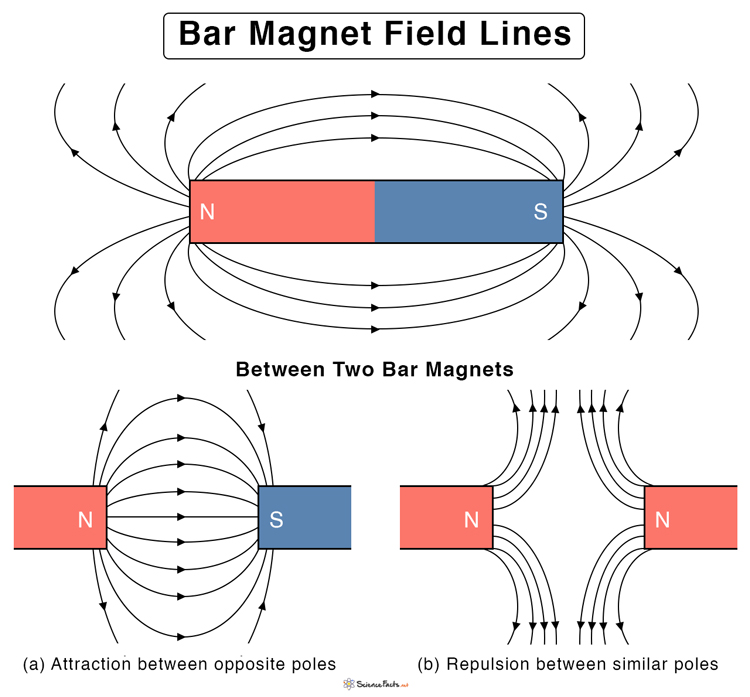The matter around us is made of atoms. What are atoms made up of? (p.194)
Atoms are made of protons, neutrons, and electrons.
While the force of gravity always attracts objects, electric charges can be either attractive or repulsive.
If two objects are both positively charged, will they attract or repel each other? (p.195)
Repel.

What do we call the transfer of electric charge between objects that are touching each other? (p.196)
Charging by contact.
What is the imbalance of electric charge on an object called? (p.198)
Static charge.
An object that loses electrons has more positive charge than negative charge. An object that gains electrons has more negative charge than positive charge.
What is the flow of electric charges called? (p.201)
Electric current.
What is the measure of the amount of electrical energy transferred by an electric charge as it moves from one point to another in a circuit? (p.205)
True or false?
The magnetic forces between magnetic poles are attractive between unlike poles. (p.209)
True.
Like poles repel, and unlike poles attract.
What type of charge do electrons have? (p.194)
Electrons have a negative charge.
If one object is positively charged, and the other object is negatively charged, will they attract or repel each other? (p.195)
Attract. Remember opposites attract!

What do we call the rearrangement of electric charge due to the presence of an electric field? (p.197)
Charging by induction.
When an object has been charged by induction, one part of the object becomes positively charged, and another part becomes negatively charged. However, the object remains electrically neutral.
What is the movement of static charge from one place to another? (p.198)
Static discharge.
What is the SI unit for current? (p.201)
Ampere.
Amperes are represented by the symbol A.
What is the relationship between the voltage, current, and resistance in a circuit known as? (p.207)
Ohm's Law.
Ohm's law can be written as the following equation: V=IR, where V is voltage, I is current, and R is resistance.
When you sprinkle iron filings around a magnetic bar, what do the lines show? (p.210)
Magnetic field lines always connect the north and south poles of a magnet.

What type of charge do protons have? (p.194)
Protons have a positive charge.
The electric force between two charged objects depends upon the distance between the objects.
If two electrons move farther apart, will the electric force between them increase or decrease? (p.195)
Decrease.
The electric force decreases as the distance between the objects increases.
What is a material in which electric charges can move easily? (p.197)
Conductors.
The best conductors are metals such as gold, silver, and copper. Because electrons move easily in copper, it is widely used in electric wires.True or false?
Charging by induction causes a spark to jump from your hand to the doorknob after you have walked on carpet. (p.198)
True.

True or false?
When a current flows in a wire, the same number of charges flow into and out of the wire. (p.201)
True.
The wire remains electrically neutral.
What type of circuit has only one path for electric current to follow? (p.208)
Series circuit.
In a series circuit, devices are connected in only one closed path for current to follow.

All metals are attracted to magnets. (p.210)
False.
Only metals that contain iron, nickel, cobalt, and a few other rare-earth elements are attracted to magnets.
What is the name for an object that has an equal amounts of positive and negative charge? (p.194)
Electrically neutral.
Because an atom has equal numbers of protons and electrons, it contains equal amounts of positive and negative charge.
The electric force between two charged objects also depends on the amount of charge on each object.
If the amount of charge on one object increases, will the electric force between the objects increase or decrease? (p.195)
Increase.
As the amount of charge on either (or both!) objects increases, the electric force between them also increases.
What are materials in which electric charges do not move easily? (p.197)
Insulators.
Examples of insulators are plastics, glass, rubber, and wood.
What is an example of electric discharge that occurs in nature? (p.199)
Lightning.

Electric current will flow continuously only if the charges flow in a closed path. What do we call a closed path in which electric charges can flow? (p.202)
Electric circuit.
What type of circuit has more than one path for current to follow? (p.208)
Parallel circuit.
Devices are connected so that there is more than one closed path for current to follow in a parallel circuit.

What is a current-carrying wire wrapped around an iron core? (p.212)
An electromagnet.
The direction of the electric current will direct which end is the north pole, and which end is the south. Electromagnets are temporary magnets.

What do we call an object that has an unequal number of positive and negative charge? (p.194)
Electrically charged.
If an atom gains or loses an electron, it is electrically charged.
How can electric charges exert forces on each other if they are not touching? (p.196)
An electric charge is surrounded by an electric field that exerts on other electric charges.

The electric field around a positive charge points away from the charge. The electric field around a negative charge points toward the charge.
What do we call the measure of how difficult it is for electrons to flow in an object? (p.203)
Electric resistance.
The resistance of insulators is usually much higher than the resistance of conductors.
Grounding.
By attaching a metal lightning rod to the top of the building. When lightning strikes the lightning rod, the electric charges in the lightning flash flow through the connecting wire into the ground. Earth is able to absorb large quantities of excess electric charge.
What type of energy conversion occurs in a battery that is connected in a circuit? (p.202)
Chemical to Electric.
What is a group of atoms in a magnetic material with the magnetic poles of the atoms pointing in the same direction? (p.211)
Magnetic domain.
In a permanent magnet, the poles of the magnetic domains point in the same direction.
What is the production of an electric current by moving a magnet and a wire coil relative to each other? (p.213)
Electromagnetic induction.